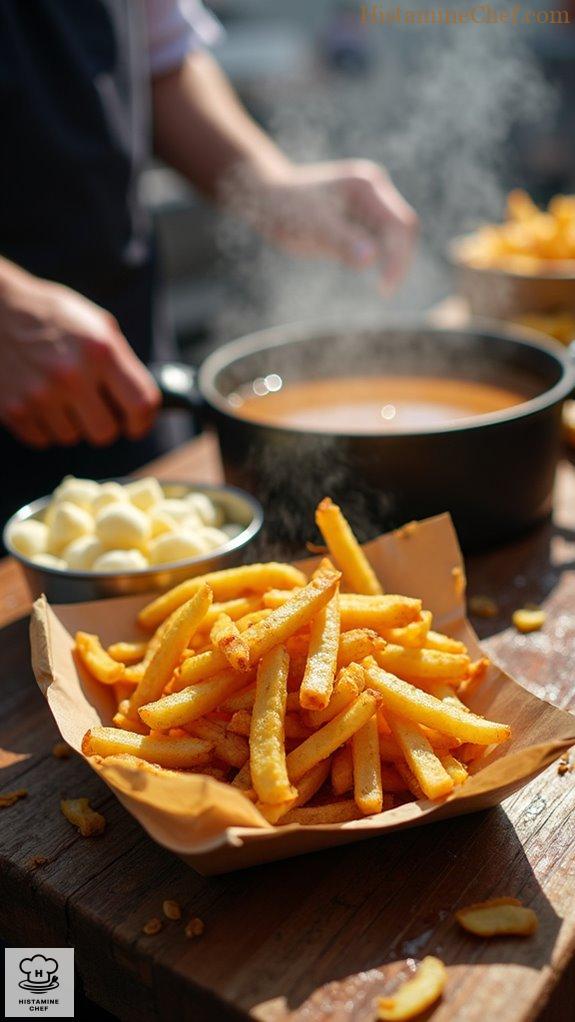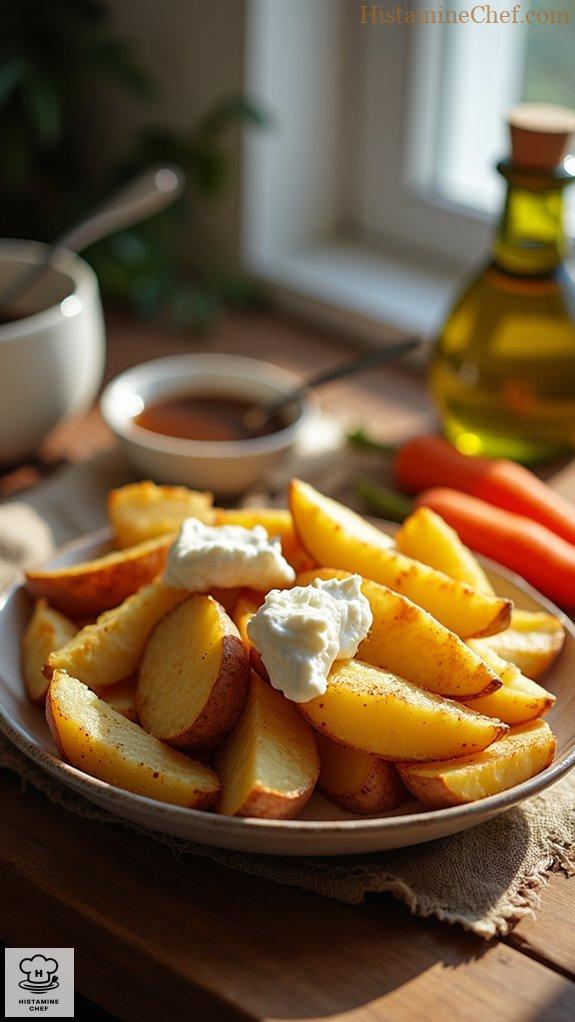Ever craved the ultimate comfort food but worried about histamine? Let me introduce you to a homemade Canadian poutine that won’t leave you feeling like a balloon animal! Picture crispy, golden fries drizzled with rich, low-histamine gravy, made from fresh ingredients. Swap those aged cheese curds for young Gouda or mozzarella, and you’ve got a dish that’s as thrilling as it is stomach-friendly! Intrigued? Stick around, and I’ll share how to whip this up in no time!
Distinctive Canadian Street Food

The street food culture in Canada is a vibrant reflection of its diverse culinary heritage, where traditional flavors and innovative pairings come together to create unique offerings.
Iconic dishes like poutine, which combines crispy fries, rich gravy, and cheese curds, represent the fusion of savory comfort food and local ingredients. Street food in Canada has deep roots, with influences from Indigenous peoples and French settlers who brought their own culinary traditions. Notably, poutine is known as Canada’s most famous dish, further emphasizing its significance in the nation’s culinary landscape.
Over the years, the scenery has evolved to include a variety of dishes such as cretons, tourtière, and beaver tails, each highlighting regional specialties and seasonal ingredients. As street food grew in popularity, it embraced not only traditional meat-based dishes but also vegetable-centric options, catering to a broader audience and dietary preferences.
With food trucks and stalls becoming common sights at festivals and urban markets, Canadian street food today is a celebration of flavors, creativity, and community, inviting everyone to savor the rich cultural tapestry that defines the nation’s culinary scene.
Homemade Canadian poutine therefore stands as a proof of the significance of street food, connecting generations and bridging cultural divides through its delicious simplicity.
Fries Topped With Gravy Outdoors

Street vendors cooking poutine outdoors begin by peeling and cutting fresh russet potatoes into fries, ensuring even thickness for consistent frying.
They heat oil in a large, deep fryer to around 350°F (175°C) and fry the potatoes in small batches, aiming for a golden-brown color and a crispy exterior while keeping the inside fluffy.
Once fried, the excess oil is drained, and the fries are placed in heat-retaining trays.
Immediately, hot brown gravy, prepared in advance and kept warm, is poured over the fries to gently melt the squeaky cheese curds sprinkled on top.
This quick assembly is essential in outdoor settings, ensuring that the fries remain crisp even after adding the gravy, providing a warm and satisfying street-side dish.
Ingredients Needed:
- 4 large russet potatoes
- 2 cups cheese curds
- 4 cups hot brown gravy
- Vegetable oil (for frying)
- Salt (to taste)
- Pepper (to taste)
- Optional toppings (sausage, mushrooms, etc.)
- Disposable trays or cardboard containers
Cooking Steps:
- Peel and cut potatoes into fries.
- Heat oil to 350°F (175°C).
- Fry potatoes in small batches.
- Drain oil from cooked fries.
- Place fries in heat-retaining trays.
- Pour hot gravy over fries.
- Add cheese curds on top.
- Serve immediately to customers.
Prepare Low-Histamine Gravy

To prepare a low-histamine version of Canadian poutine at home, begin by making the gravy using allowed ingredients. Start by heating extra virgin olive oil in a pan, and then add gluten-free flour (or cornstarch) to create a roux.
Slowly whisk in allowed beef broth or water, thickening the mixture to achieve a smooth consistency. Season with approved herbs such as thyme and salt for flavor.
For the fries, cut potatoes into desired shapes, and bake or fry in coconut oil until golden and crispy.
Assemble the dish by layering the fries, adding the gravy, and topping with allowed cheese like mozzarella or young Gouda.
- Use extra virgin olive oil
- Replace flour with gluten-free option
- Make gravy with beef broth or water
- Season with thyme and salt
- Bake or fry potatoes in coconut oil
- Use mozzarella or young Gouda cheese
- Assemble fries, gravy, and cheese
Low Histamine Variation of Poutine

Histamine intolerance can complicate the enjoyment of street food, like poutine, due to the high levels of histamine often found in processed and preserved ingredients common in these dishes.
Many street food options use ingredients that are either high in histamine or classified as liberators, making them problematic for those affected by this condition.
Eating street food can present challenges for individuals with histamine intolerance because the sauces and toppings typically used, such as cheese and seasonings, may contain high-histamine ingredients (like aged cheese and certain spices) as outlined in the SIGHI list.
Furthermore, prepared foods sold on the street might also have additives or preservatives, further exacerbating the risk of histamine reactions in sensitive individuals.
To prepare a low histamine variation of Homemade Canadian Poutine, follow these steps:
- Use fresh curds instead of aged cheese for toppings.
- Opt for oven-baked potatoes instead of fried for the base.
- Avoid using stock or bouillon; make your gravy from scratch.
- Use a low histamine oil like olive oil for cooking.
- Season the dish with allowed herbs, avoiding restricted spices.
- Prepare gravy with allowed ingredients like beef or vegetable broth (homemade).
- Substitute corn-based starch for thickening if needed.
- Serve with a side of permitted vegetables (like carrots).
- Keep the dish free from any processed sauces or flavorings.
- Always check ingredient labels for hidden high-histamine additives.
Additionally, you can explore suitable alternatives like vinegar substitutes that are histamine-friendly in your cooking.
Video Summary
Poutine has its roots in Quebec, Canada, where it first emerged in the late 1950s. In this video, we’ll show you the authentic street version and a lower histamine homemade variant.
Street vendors create the classic poutine with crispy French fries, rich gravy, and squeaky cheese curds. They start by frying potatoes in hot oil until golden brown. Next, they prepare a flavorful gravy using beef or chicken stock with added thickening agents.
Once the fries are ready, they generously pile them on a plate. The next step is adding the hot gravy, ensuring it seeps into the fries. Finally, they top the dish with fresh cheese curds, letting them melt slightly.
For the homemade low histamine version, you’ll use different ingredients and methods. Start with fresh potatoes, sliced into fries. Bake or air fry the fries with extra virgin olive oil until crispy.
For the gravy, make a simple one using a mix of water and coconut milk. Add a pinch of salt for flavor. Thicken the mixture using baking soda instead of traditional thickeners.
Layer your crispy fries on a plate, just like the street version. Pour the homemade gravy over the fries, allowing it to coat them well. Instead of cheese curds, use young Gouda or mozzarella, as they’re allowed.
The finished meal is a delightful blend of crispy, creamy, and savory flavors. Click the link in the description for the full recipe.
Questions and Answers
Can I Use Frozen Fries for Low-Histamine Poutine?
Absolutely, I’ve found that frozen fries can fit well into a low-histamine diet. Just double-check the ingredients for any hidden restrictions, and you’ll be good to go for a tasty treat!
What Type of Cheese Is Suitable for Low-Histamine Diets?
For low-histamine diets, I find young cheeses like mozzarella or cream cheese work best. They’re fresh, less aged, and tend to cause fewer issues, so I always keep them stocked in my kitchen.
How Long Can I Store Homemade Low-Histamine Gravy?
Storing homemade low-histamine gravy is like safeguarding treasure. I keep it in the fridge for up to three days, ensuring it’s tightly sealed, preserving its flavor and potency, ready to rise again in delicious meals.
Is It Possible to Make Poutine Vegan-Friendly?
Absolutely, I can create a vegan-friendly version. I’ll swap traditional cheese for a creamy cashew alternative and use plant-based gravy, ensuring I stick to ingredients that keep our health in mind, while tasting fantastic!
What Sides Pair Well With Low-Histamine Poutine?
Envision a culinary dance. Crisp, golden fries waltz with tangy apple slices and a fresh cucumber salad. These vibrant sides bring balance and energy, enhancing the poutine’s rich heartiness while keeping histamine levels in check.
References
- https://thebanffblog.com/canadian-food/
- https://www.queensleeappetit.com/authentic-canadian-poutine-recipe/
- https://www.insightvacations.com/blog/canadian-food/
- https://www.tasteofcanada.de/en/categories/streetfood
- https://recipes.howstuffworks.com/poutine-canada.htm
- https://carlsbadcravings.com/poutine/
- https://en.wikipedia.org/wiki/Poutine
- https://www.allrecipes.com/recipe/79300/real-poutine/
- https://www.statcan.gc.ca/o1/en/plus/739-french-fries-canadian-way


Leave a Reply